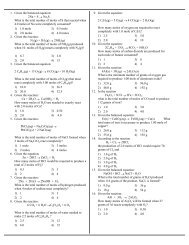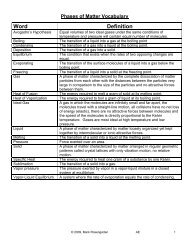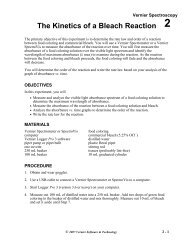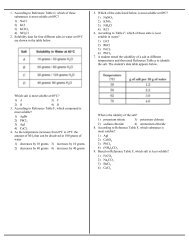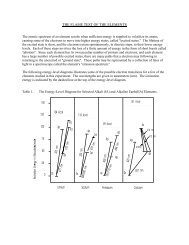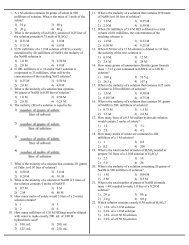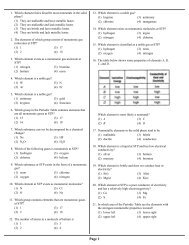Kinetics, Thermodynamics and Equilibrium - Revsworld
Kinetics, Thermodynamics and Equilibrium - Revsworld
Kinetics, Thermodynamics and Equilibrium - Revsworld
You also want an ePaper? Increase the reach of your titles
YUMPU automatically turns print PDFs into web optimized ePapers that Google loves.
F) For the following PE Diagram, answer the questions below:<br />
_____1) What is the heat of reactants?<br />
a) 30 kJ b) 110 kJ c) 140 KJ d) 160 kJ<br />
_____2) What is the heat of the products?<br />
a) 30 kJ b) 110 kJ c) 140 KJ d) 160 kJ<br />
_____3) What is the heat of the activated complex for the uncatalyzed reaction?<br />
a) 30 kJ b) 110 kJ c) 140 KJ d) 160 kJ<br />
_____4) What is the activation energy for the catalyzed reaction?<br />
a) 30 kJ b) 110 kJ c) 140 KJ d) 160 kJ<br />
_____5) What is the ∆H of this reaction?<br />
a) + 80 kJ b) – 80 kJ c) +130 kJ d) -130 kJ<br />
_____6) What type of reaction is this?<br />
a) exothermic b) endothermic c) both d) neither<br />
7) Draw a dashed line on the above diagram to indicate what the graph would look like if a catalyst was added<br />
to this reaction, using the catalyzed reaction line as your guide.<br />
G) For the following PE Diagram, what does each arrow represent?<br />
a) Heat of Reactants ________<br />
b) Heat of Products ________<br />
c) Activation Energy ________<br />
d) ∆H ________<br />
e) Heat of Act. Cmplx ________<br />
f) Sketch a dashed line to indicate the effect of<br />
adding a catalyst.<br />
© 2009, Mark Rosengarten AE 26






